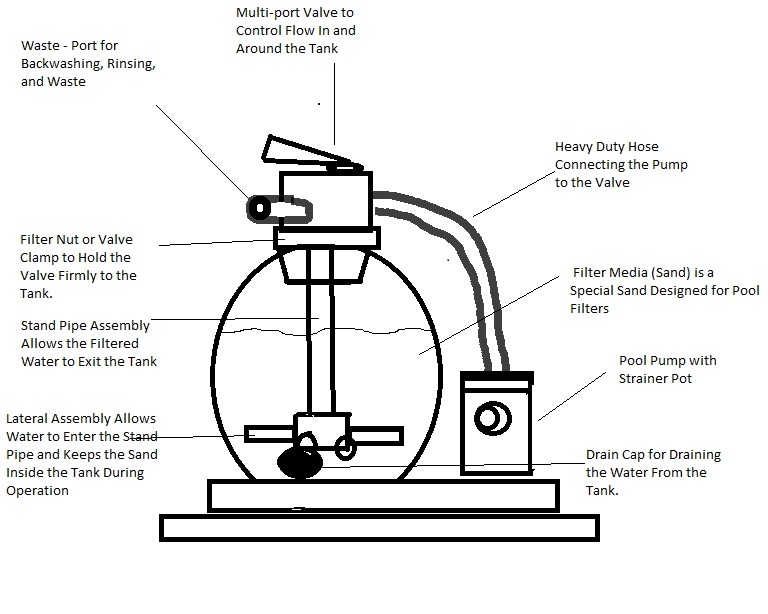Sand Filters - Operation and Maintenance
Sand filters are generally round or oval shaped tanks standing 3 to 4 feet tall and 2 to 4 feet in diameter. Most units have a multi-port valve either atop the tank or off to one side. A special grade of filter sand fills the tank about 3/4 of the way and water is forced through the sand, trapping dirt and debris.
How They Work
Water from the swimming pool is pushed directly from the pump into the valve of the sand filter. Here, it is directed down through the sand and up through a solid pipe, back into the valve. Kept separate from the water coming into the vessel, it exits the valve and moves on toward the pool's return lines.

Most sand filter control valves have from four to seven settings, each having their own specific purpose. These settings often vary slightly from one brand of filter to the next, but understanding when and how they are used is the key to using the system.
The most common settings found on a sand filter valve are Filter, Backwash, Rinse, Recirculate, Waste, Closed, and Winterize.
Below, you will find general explanations of each setting, but you should refer to your filter system owner's manual for more specific information. Keep in mind that whenever the selection is changed on the valve, the pump should be turned off.
Filter - This is the main setting, directing water flow through the sand for cleaning.
Backwash - When impurities are removed from the water, they remain in the sand inside of the tank. When enough dirt and debris is collected, the flow of water through the tank becomes hindered, building backpressure and slowing circulation. When this happens, it is time to clean out the filter. Backwashing uses clean water from the swimming pool to flush out the tank, but leaves the sand inside the tank.
When the backwash selection is used, the water flows through the tank in reverse, pushing the collected dirt up through the sand and out through the waste line on the valve. Once all of the dirt is flushed, the water will run clear again, and the circulation will usually improve.
Rinse - After backwashing, the rinse setting is used to flush any remaining dirt and debris from the valve into the waste line. Using this helps prevent any sand or filtered debris from entering the swimming pool once the system is returned to "Filter" mode. This is usually done for about 15 seconds.
Recirculate - This setting is used to troubleshoot problems with the filter sand and is especially useful if you are battling an algae bloom. The water will circulate in the pool normally, but will bypass the filter sand.
Heavy debris, like leaves and algae, can quickly plug up the sand in the filter, requiring a backwash within a very short amount of time. By using recirculate, you can keep the water moving, circulate the chemicals you are using, and keep the debris inside the pool, where it can be vacuumed to waste.
Waste - Used primarily while vacuuming to remove heavy debris from the floor of the pool. The water will bypass the filter sand and go directly into the waste line, where the debris will be removed from the swimming pool completely. Great for spring cleanups and removing dead algae.
Closed - This shuts off water flow to and from the valve, allowing you to perform maintenance on the pump and/or sand tank. When emptying the basket on the front of your pump, you should use this setting to prevent water from flooding up through the strainer pot when the lid is removed.
Winterize - When it comes time to empty the filter system, either to change the sand or to winterize the pool, this setting should be used. It simply allows air to enter the valve, helping to drain the water from the system once the drain cap is removed.